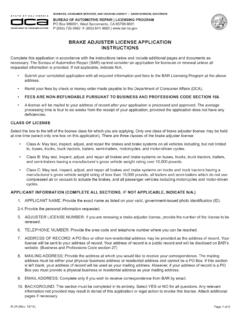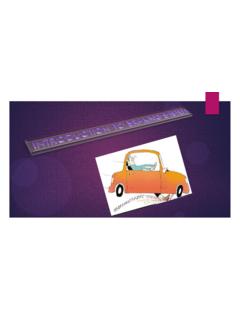Transcription of Table of Contents - Federal Motor Carrier Safety ...
1 Table of Contents Introduction ..1 Air brake Systems ..2 Important Points about Air brake Systems ..4 Anti-Lock Braking Systems (ABS) ..5 ABS Based Safety Technologies ..8 A Typical Scenario With/Without Traction Control ..9 Important Points about ABS and Related Technologies ..11 Safe Use of Cruise Control ..12 Points about Retarders ..16 brake Fade ..17 Important Points about brake Fade ..20 Driving Tips and Cautions ..21 Where to Go For Additional Information ..22 1 IntroductionThis booklet provides information and guidance to motorcoach drivers who have the challenge of understanding and properly handling complex mechanical devices, technologies, and Safety related systems. Each section of this booklet concludes with important summary points.
2 Always refer to the manufacturer s operating instructions for specific vehicle model booklet will answer the following questions: What is the acceptable air system leakage limit above which you should not operate the motorcoach? (answer on page 2) What does your air pressure gauge tell you? (answer on pages 2 & 3) What does it mean when the ABS light is lit while you are driving? (answer on pages 6 & 7) When should cruise control not be used? (answer on page 12) Should you use a retarder on a slippery road? (answer on pages 15 & 16) How much longer will it take you to stop when traveling at 60 mph with drum brakes instead of disc brakes after repeated brake applications?
3 How much longer at 75 mph? (answer on page 20)2 Air brake SystemsAll air-braked motorcoaches built since March 1, 1975 for operation in the United States must meet minimum requirements known as Federal Motor Vehicle Safety Standard 121, Air brake Systems or FMVSS 121. This booklet will cover the most common air brake system designs from 1975 to Compressor and air system Pressure - You should be aware of common air pressure thresholds of your motorcoach s brake system . The air pressure gauge tells you the adequacy of the air system . Air compressors typically have a cut-out pressure between 110 psi and 130 psi and a cut-in pressure about 20 psi lower. Air pressure build-up from 85 psi to 100 psi should take 45 seconds or less.
4 While driving, observe the air pressure gauge during build-up to ensure proper air system operation. Every motorcoach is different, some by design and some by condition. Know what is typical for your motorcoach. To test air system integrity, make and hold a full brake application for at least 2 minutes while watching the air pressure gauge with the engine off, the key in the on position, and the park brake off. Leakage, if present, should be less than 5 psi for the 2 minutes. Continue the test by applying the park brake and then pumping the brake pedal to release air. A visual warning should activate when the air pressure gauge drops below 60 brake SystemsAir pressure gauges - The most common air brake system designs since March 1, 1975 isolate the front axle system from the rear axle system and have two air pressure gauges.
5 The gauges for both air systems show how much air is consumed during braking and when the compressor activates to build up pressure. If you notice frequent activation (compressor cut-in and cut-out) or excessive air loss in either system during braking, pull over at a safe place and perform the 2 minute / 5 psi leakage test. If a failure occurs in either the front or rear axle system , there is usually enough air in the other axle system to bring the vehicle to a safe stop. You should seek brake system service immediately if one system fails. Caution about park brakes - Remember the park brakes are for parking only and are not designed as emergency brakes. Always leave the transmission in neutral (both manual and automatic) when applying the park Points About Air brake Systems: Air Leakage - Frequent compressor cycling usually indicates an air loss somewhere in the air brake system .
6 It is unsafe to operate a motorcoach with a noticeable air leak. Even though frequent compressor cycling may maintain adequate air system pressure, you should seek a brake system inspection without delay. Air Pressure Gauges - It is advisable to continuously monitor the gauges for early detection of system malfunction such as unusual or imbalanced air consumption. Any leak in the air system can affect the braking performance of your motorcoach. Low Pressure Warning - In most cases, you should notice an air leak or malfunction before getting a low pressure warning. When a low pressure warning occurs, immediately bring the motorcoach to a safe stop, off of the roadway. Continuing to operate the motorcoach could result in an automatic application of the park brakes, possibly leading to a loss of control or a stop in an unsafe position.
7 Continual Awareness - Know your motorcoach, its features, and its condition at start-up and throughout the trip. Proper Use of Park Brakes - The park brakes should only be used to park. Do not use the park brakes to stop the motorcoach during an emergency. Be prepared to handle a malfunction at any Braking Systems Since March 1, 1998, new motorcoaches are required to have an anti-lock braking system (ABS). An ABS monitors all wheels for skidding during brake application and momentarily releases some or all of the brake action until the skid stops. The basic function of an ABS is to prevent wheel lock and provide directional control during braking. ABS keeps the wheels rolling for optimum braking and steering.
8 On some slippery surfaces, ABS can provide wheel lock control that may not be readily detected by the driver. Because most highway travel is on dry pavement and the typical brake application is less than 20 psi, the ABS seldom activates. It is important for you to know whether the motorcoach that you are operating has an ABS. If your motorcoach is ABS equipped, you should know how to use this technology and be familiar with the signals of ABS malfunction. 6 Anti-Lock Braking SystemsABS Lamp on the Instrument Panel - Turn the ignition key to on and look for the yellow lamp, light, or lighted icon on the instrument panel marked ABS. After engine start-up, the system does a self-diagnosis and, if no malfunction is found, the lamp will turn off after a few seconds.
9 When the motorcoach speed approaches 6 to 10 mph, the system checks for proper wheel speed signals. The sequence at motorcoach start-up is: Lamp On system Check Followed by Lamp Off system OKCritical malfunctions or signals that shut down all or part of the system will activate the ABS lamp. The two most important messages to remember are:Vehicle Start-up No Yellow ABS Light Means No ABSW hile Driving Yellow ABS Light Illuminates Means ABS Malfunction On some earlier production systems, the lamp remains lit until the motorcoach speed reaches 6 to 10 Braking SystemsWhat to do when the ABS light illuminates - If the yellow light illuminates while driving, the ABS is malfunctioning and should be inspected as soon as possible.
10 The malfunction could be as simple as a loose wire or sticking modulator valve. It is a Safety violation to operate a motorcoach with a malfunctioning ABS. ABS malfunctions leave the motorcoach with a traditional braking system which means the driver has more responsibility for motorcoach braking and handling. What to do when ABS activates - When ABS activates, you may or may not feel the ABS operating. When you must slow or stop the motorcoach quickly and whenever ABS activates, keep a steady brake application and let the ABS modulate the brake pressure as needed. You will not see the yellow ABS light when ABS activates. The purpose of the ABS light is to tell you the ABS may be malfunctioning and needs Based Safety TechnologiesABS based technologies include traction control systems, electronic stability control systems, and anti-roll systems.













